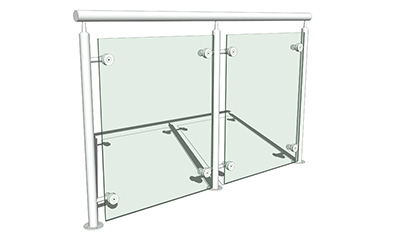Introduction
Glass balustrades are a stylish and modern addition to any architectural design, offering transparency, elegance, and functionality. However, ensuring their safety and compliance with regulations is paramount. Comprehensive testing procedures are crucial to guaranteeing the durability, strength, and safety of glass balustrades. In this guide, we delve into the importance of glass balustrade testing, the various testing methods employed, and the regulatory standards governing these tests.
1. Understanding the Importance of Glass Balustrade Testing
- Safety Assurance: Glass balustrades serve as protective barriers in various settings, including balconies, staircases, and terraces. Testing ensures they can withstand typical loads and impacts, safeguarding individuals from potential accidents.
- Structural Integrity: Testing assesses the structural strength of glass panels and their fixings, ensuring they can withstand environmental factors such as wind loads, vibrations, and temperature changes.
- Compliance with Regulations: Regulatory bodies mandate specific standards for glass balustrades to ensure public safety. Testing ensures compliance with these standards, mitigating liability risks for property owners and developers.
2. Common Testing Methods for Glass Balustrades
a. Impact Testing: This involves subjecting glass panels to controlled impacts to simulate accidental collisions or forceful impacts. Tests measure the glass’s resistance to breakage and fragmentation, ensuring it remains intact under stress.
b. Load Testing: Load tests assess the structural integrity of glass balustrades by applying vertical and horizontal loads. These tests simulate the weight of leaning or falling against the balustrade, ensuring it can support such loads without failure.
c. Deflection Testing: Deflection tests measure the amount of flex or bend in the glass under load. Excessive deflection can indicate structural weakness or inadequate support, highlighting potential safety hazards.
d. Thermal Stress Testing: Glass panels are subjected to temperature variations to assess their resistance to thermal stress. Rapid changes in temperature can cause glass to expand or contract, leading to cracks or breakage. Thermal stress tests ensure the glass can withstand such fluctuations without failure.
e. Durability Testing: These tests evaluate the long-term performance and resistance of glass balustrades to environmental factors such as UV exposure, moisture, and chemical exposure. Durability testing ensures the longevity of the balustrade system.
3. Regulatory Standards for Glass Balustrade Testing
- ASTM International Standards: ASTM E2353-16 outlines the standard test methods for testing the performance of glass in balustrades, including impact resistance, load-bearing capacity, and deflection limits.
- European Norms (EN): EN 12600 and EN 1990 provide guidelines for assessing the impact resistance and structural design of glass balustrades in Europe, ensuring compliance with safety standards.
- Building Codes: Local building codes and regulations stipulate requirements for glass balustrade design, installation, and testing to ensure adherence to safety standards and building practices.
4. Benefits of Conducting Glass Balustrade Testing
- Enhanced Safety: Testing identifies potential weaknesses or defects in the balustrade system, allowing for remedial action to be taken before installation, thereby reducing the risk of accidents or injuries.
- Compliance Assurance: Testing ensures compliance with industry standards and regulatory requirements, providing peace of mind to property owners, architects, and developers regarding legal and safety obligations.
- Quality Assurance: By testing glass balustrades for durability and performance, manufacturers can uphold quality standards and reputation, fostering customer trust and satisfaction.
Glass balustrades are an aesthetically pleasing and functional architectural feature, but their safety and durability hinge on rigorous testing procedures. By conducting comprehensive tests, including impact, load, deflection, thermal stress, and durability testing, manufacturers, architects, and property owners can ensure the structural integrity and compliance of glass balustrade systems. Adhering to regulatory standards and industry best practices not only enhances safety but also instills confidence in the reliability and longevity of these architectural elements.
For personalized glass solutions that exceed expectations, Glass World can be your trusted partner. Get in touch with us today to explore our extensive range and find the ideal glass products for your projects.

